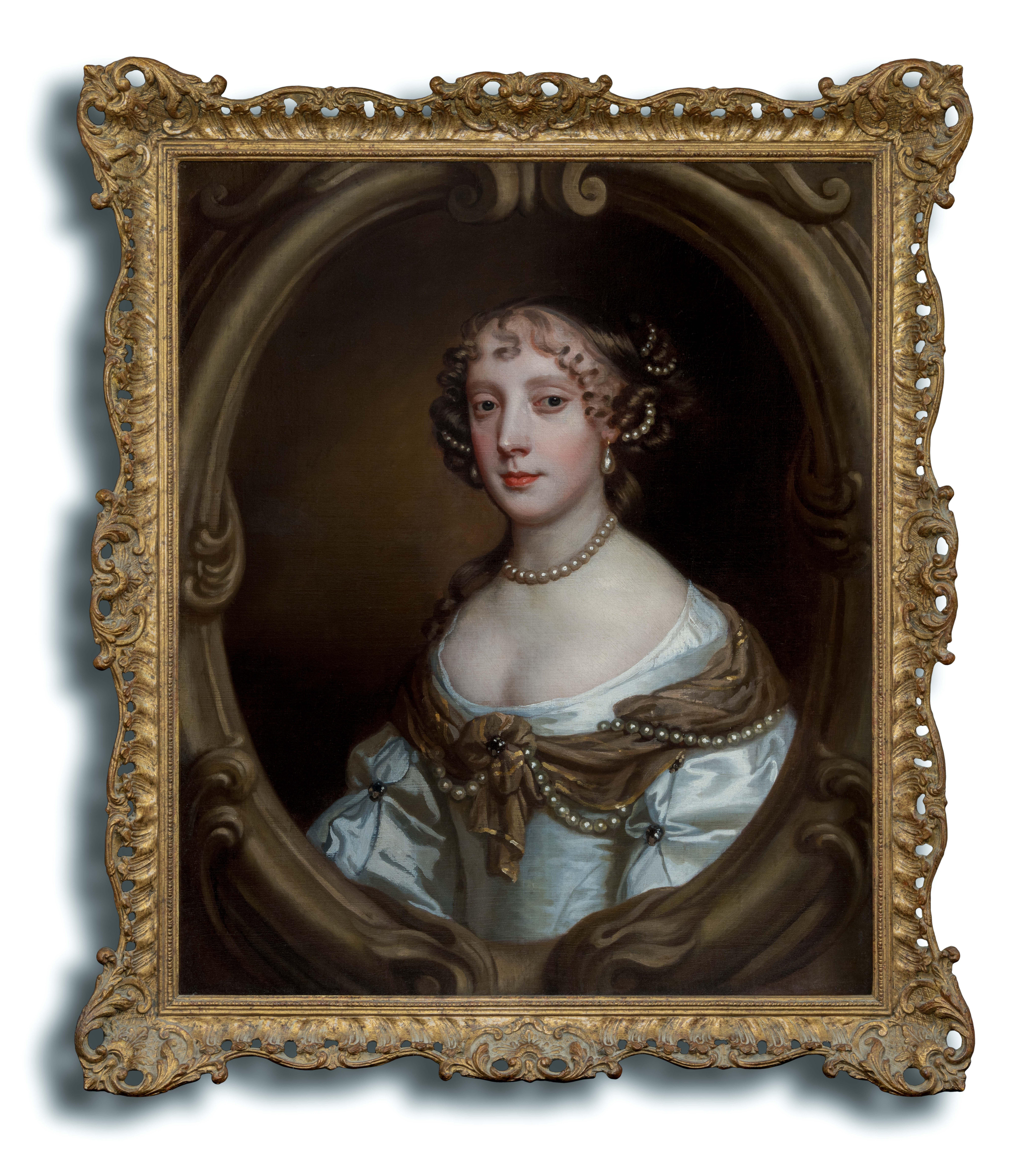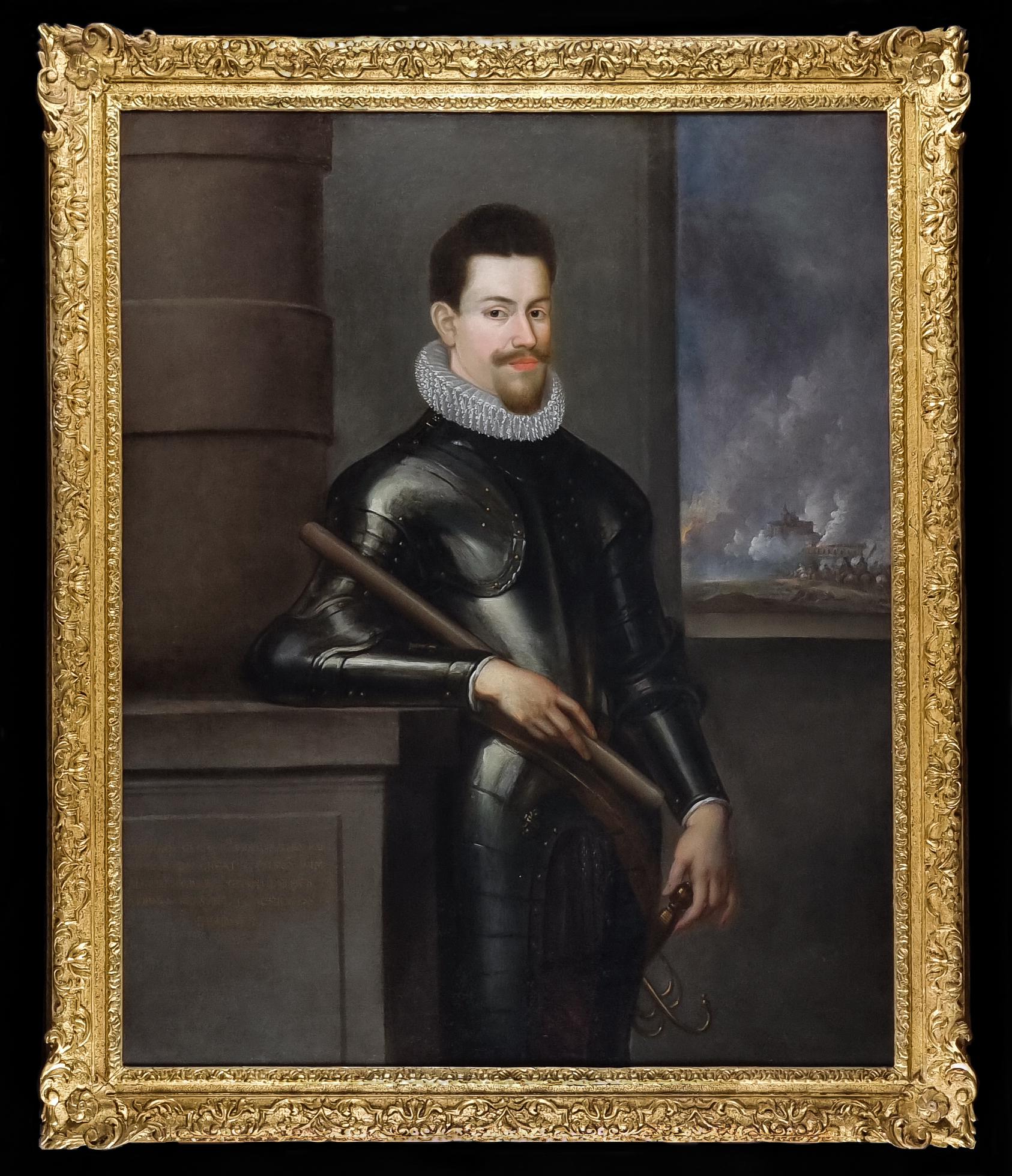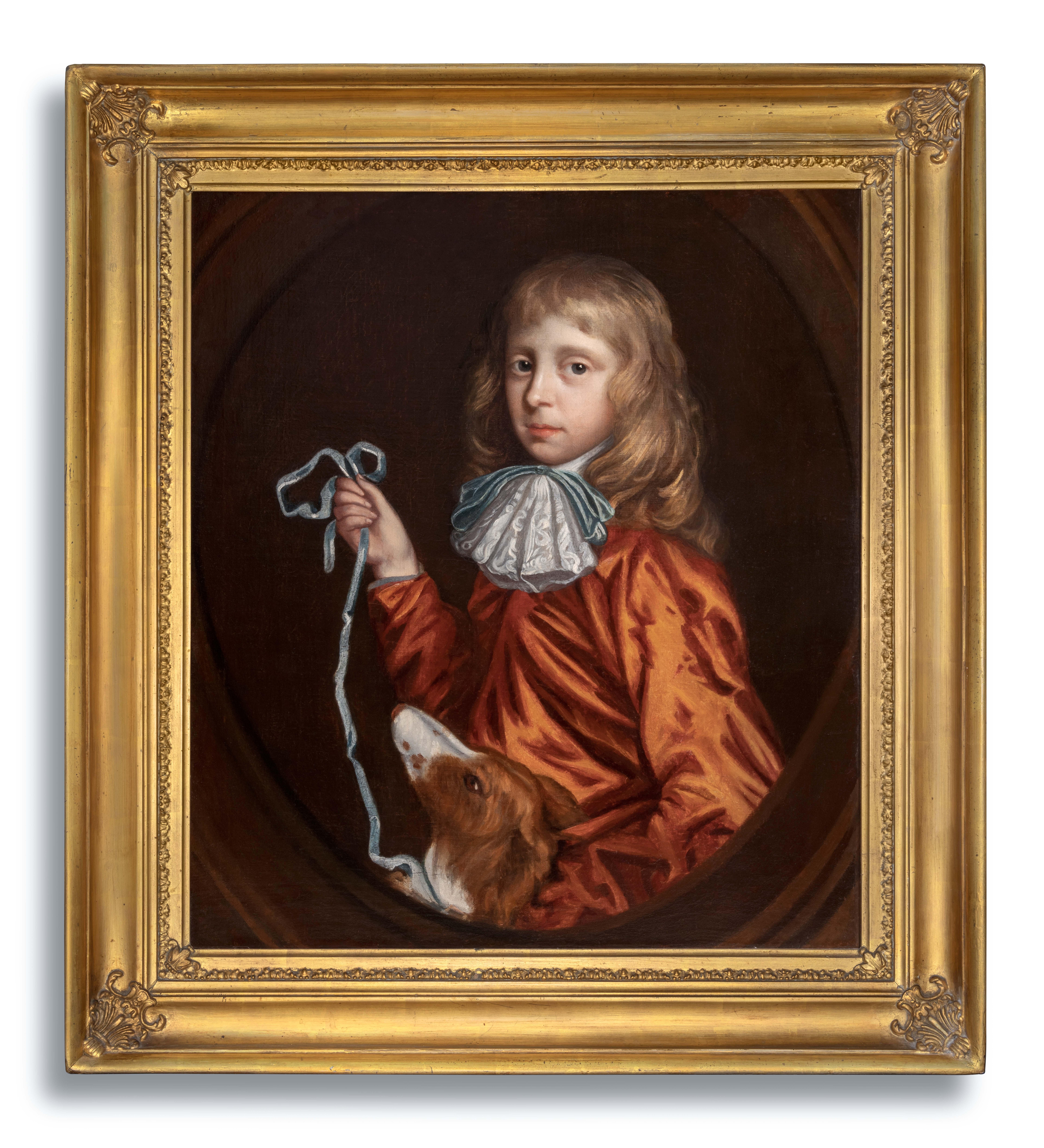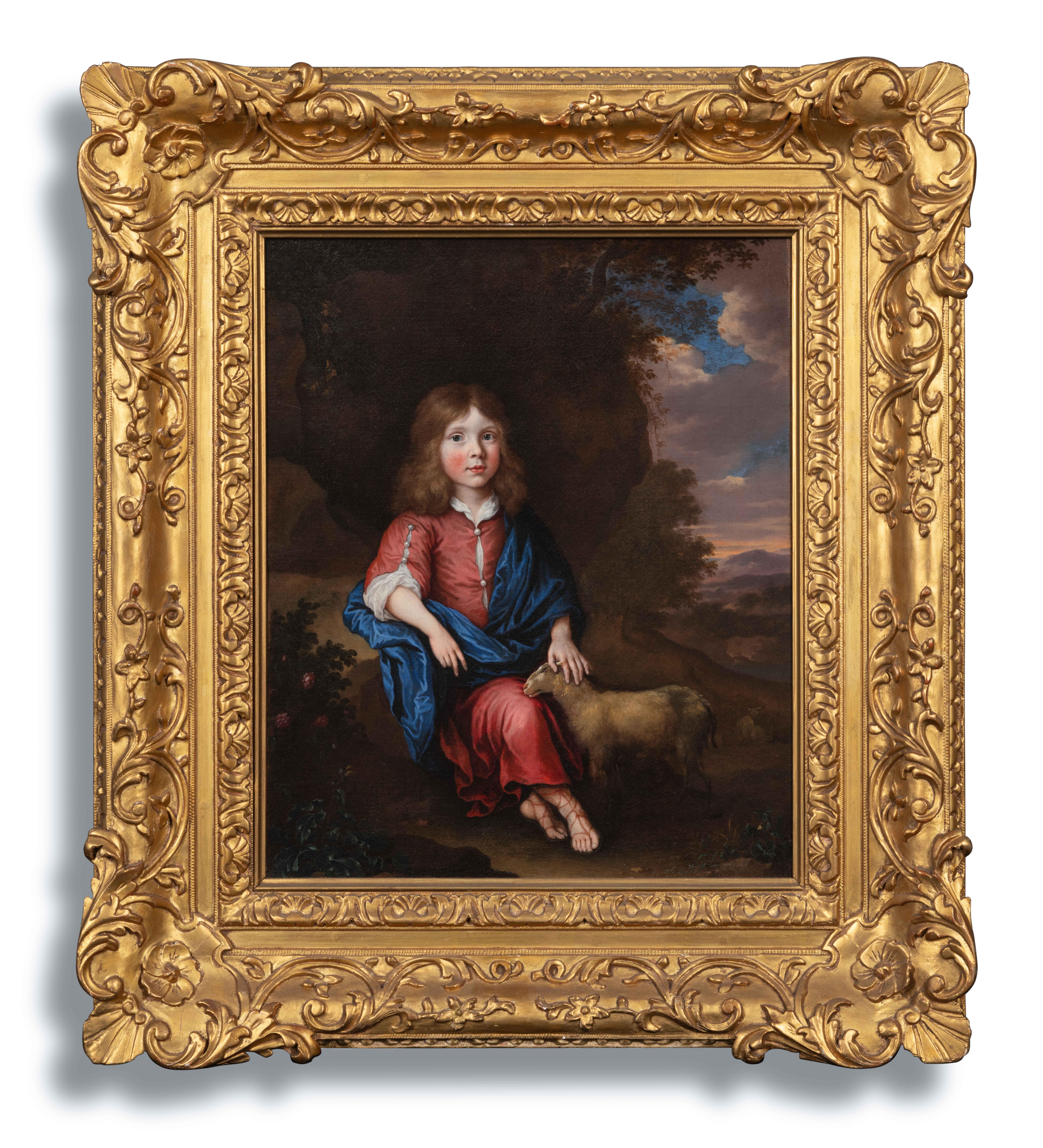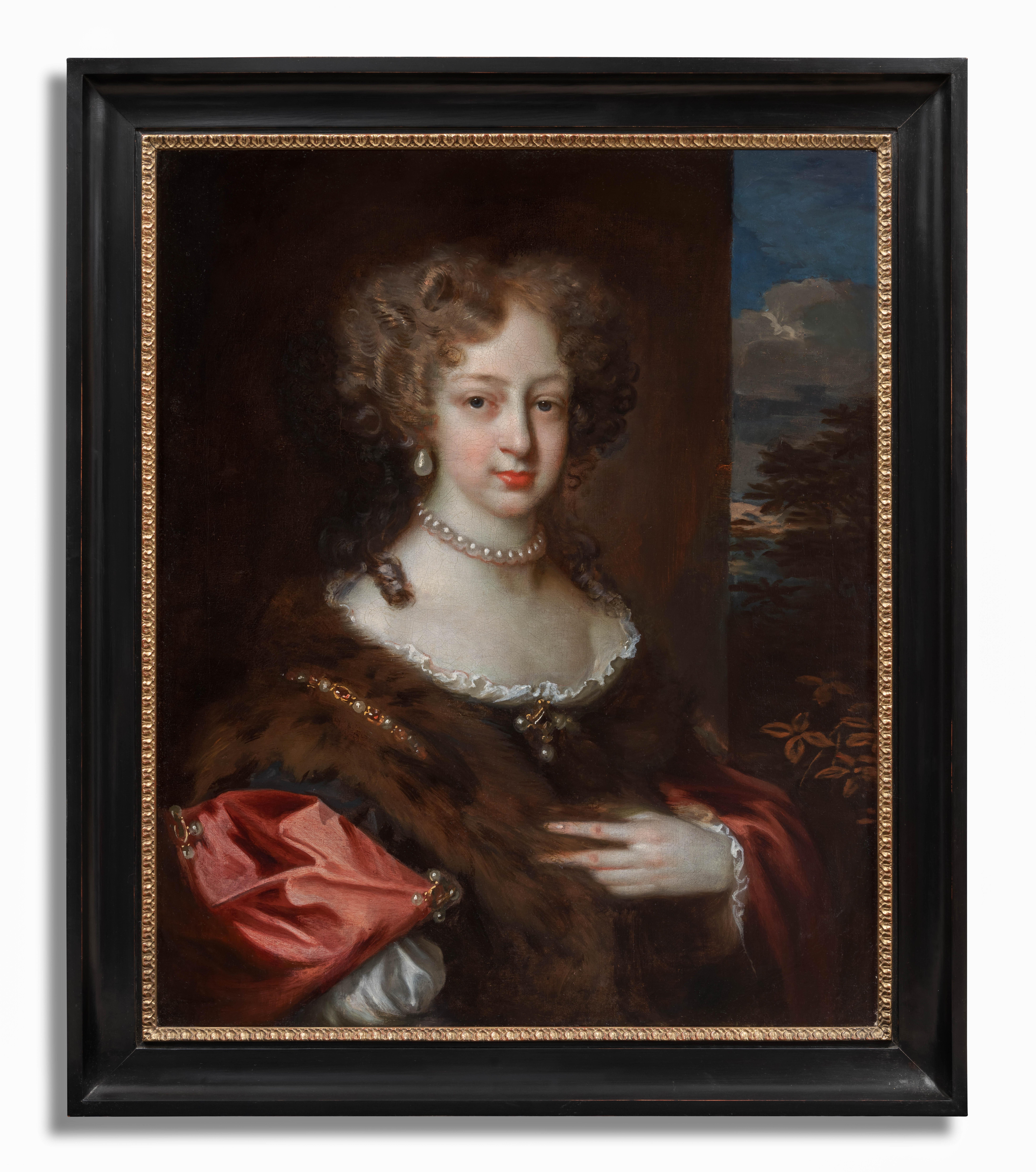Items Similar to Double Portrait of Sir John Rivers 3rd Baronet of Chafford, and Lady Anne Rivers
Want more images or videos?
Request additional images or videos from the seller
Sir Peter Lely and StudioDouble Portrait of Sir John Rivers 3rd Baronet of Chafford, and Lady Anne Riverscirca 1662
circa 1662
About the Item
This magnificent grand-scale work, offered by Titan Fine Art, formed part of a collection of family pictures and heirlooms of the Rivers Baronets and their descendants for over 325 years, before it was dispersed by the last in the line in 1988. The work was painted by the most technically proficient painter in England after the death of Van Dyck, and the dominant court painter to Charles II and James, Duke of York, Sir Peter Lely. It is no surprise that for years Lely had no serious rivals, was enormously influential and successful, and one of the country’s most important painters – and his work influenced countless artists over generations. The exquisite carved and gilded auricular frame is an astounding work of art in itself.
The sitters in this exquisite double portrait are Sir John Rivers, who succeeded as the 3rd Baronet Chafford in 1657 (c.1638 - c. 1679), and his wife, Lady Anne Hewitt (c.1640-c.1689). They are seated in an outdoor setting beside a fountain modelled as a female figure with water issuing into a scallop-shell. The water, the elaborate sculpted fountain with its scallop-edged bowl, and the open shell in her hand are symbols of fertility - as such they make an appropriate allusion to Lady Anne’s potential as wife and mother, recalling Proverbs, chapter 5, verse 18: “Let thye fountain be blessed, and rejoice in the wife of thye youth”. This reference was realised, as Sir John and Lady Anne produced at least six children; their son George (1665-1734) became 4th Baronet of Chafford. The composition, thus, represents a celebration of marriage and was likely commissioned around the time of the betrothal (the marriage took place 26th Feb 1662 or 1663). The statues in the left margin are 'Youth and 'Old Age' and are a typical form of Memento Mori reminding virile young man that even they will lose their youth and grow old.
The Rivers family, originally of Kent, traces its history to Sir Bartholomew Rivers, in the reign of Edward IV. The family included several prominent members including several knights, a Commander in the King's Army, a steward of a ducal estate, a Lord-Mayor of London, and an M.P. John Rivers (c.1659-c.1651) was made 1st Baronet of Chafford in 1622 by King James I. The Chafford estate was the family seat and it remained so until the early 1700s with the death of Sir George Rivers, 4th Baronet (1665–1734), whose sons had all died. The Chafford estate was left to his daughters while the baronetcy passed to nephew John Rivers, 5th Baronet (c. 1718–1743), and then Sir John’s brother, Sir Peter Rivers-Gay, 6th Baronet (c. 1721–1790).
Upon Sir Peter Rivers Gay's death the estate passed to his eldest son, Sir Thomas Rivers Gay, 7th Baronet (c. 1770–1805). Sir Thomas, dying in 1805 with no children, bequeathed the estate to his mother Dame Martha Rivers Gay, who managed the estate until 1834 when she settled it on the then Sir Henry Rivers, 9th Baronet (c. 1779–1851) her younger son, before dying shortly thereafter in 1835. Sir Henry had married in 1812 to Charlotte Eales, with whom he had 6 sons and 8 daughters. Upon his death in 1851 the estate passed to his eldest surviving son Sir James Francis Rivers, 10th Baronet (1822–1869). Sir James married Catherine Eastcott in 1867 but died childless in 1869, and the estate passed to his only surviving brother Sir Henry Chandos Rivers, 11th Baronet (1834–1870) but he died a year later in 1870 also childless; with no male heir the Baronetcy was therefore extinguished.
The estate was bequeathed, in trust, by Sir Henry Chandos Rivers to Thomas Frederick Inman, a solicitor of Bath, who then managed the estate as a trustee on behalf of Sir Henry Chandos Rivers' sister Katherine Rivers (c.1826-1895). It then passed to Katherine River’s daughter, Katherine Wall (born c.1855), who had also inherited Worthy Park House from her father, George Alfred Ellis Wall (1825-1875).
Until 1958 our portrait is known to have hung at Worthy Park House. Upon Katherine Wall’s death, the Rivers estate passed to her daughter, Katherine Eleonora Rivers Fryer (1889-1963), who married Colonel James Alexander Butchart 1877-1853. In 1958 the family sold Worthy Park House but our portrait was loaned to Southampton Museum and Art Gallery. After the death of Katherine and Colonel James, the estate was left to their only son, Charles Bruce Rivers Butchart (1917-2005) and upon Charles’ retirement to a nursing home in 1988, and without heirs, our portrait, along with the residual assets of the Rivers estate were sold, thus ending over 325 years of continual family ownership.
Lady Anne Rivers is thought to have been born circa 1640. She was the fourth child of the second marriage of Sir Thomas Hewitt (or Hewett) (1606-1662), 1st Baronet of Pishobury, Herts, and his wife Margaret Lytton (died 1689). Sir Thomas was an English landowner and M.P. for Windsor and upon the English Restoration, he was created a baronet, served as commissioner of militia for the county, and was chosen sheriff of Hertfordshire. Lady Anne had four brother, seven sisters, and one half-sister from her father’s first marriage. She, and her brother George, Viscount Hewett, were coheir of their father’s estate. The precise date of her death is unknown but it was before April 1689.
Worthy Park House - The original house on the site was built in 1722. It was bought by Sir Chaloner Ogle, 1st Baronet in 1773. Admiral Sir Charles Ogle, 2nd Baronet inherited the house in 1816. He demolished the west wing and replaced it with a new building, which was completed in 1820. The house was acquired by Samuel Wall, a banker in 1825 (died 1843) and remained in the possession of his descendants, the last being, Charles Bruce Rivers Butchart, who sold the house in the late twentieth century. The sale advertisement listed it as having a “Hall, double drawing room, Esse, dining room, library, extensive offices, 14 bedrooms, 4 bathrooms, gardens, farmery and colage; 2 paddocks with road frontage. NEARLY 12 ACRES”.
The portrait, with its scale, rich colour, its exquisite draperies, and romantic setting, is an exquisite work of art - and the double portrait format, of this quality, rarely appears on the market.
Peter Lely, the son of a Dutch military officer, was born in Germany at Soest in Westphalia in 1618. He studied in Haarlem before moving to London in 1641, and in 1647 he became a freeman of the Painter-Stainers’ Company. Initially, Lely painted landscapes, religious, and mythological scenes, however, he quickly recognised the strength of the English market for portraiture and this is where he turned his attention. He was employed by the Duke of Northumberland, who had the royal children in his care, and he was able to study the Northumberland Collection of works by Van Dyke and Dobson. By the end of the Commonwealth he had became the best known portraitist in England. In 1661 he was appointed Principle Painter to the King and from then on he maintained a busy and successful practise painting the most elite and influential members of the court and everyone of importance. His studio was prolific and he employed many assistants. His success thus meant that he established the basic English portrait style for decades.
Lely was a connoisseur and was known for his own fine art collection. By the end of his life he had assembled one the finest non-princely collections in Europe including more than 25 of Van Dyke’s major English works. of Old Masters, including Veronese, Titian, Claude Lorrain and Rubens, and a fabulous collection of drawings, was broken up and sold after his death, raising the immense sum of £26,000. Some items in it which had been acquired by Lely from the Commonwealth dispersal of Charles I's art collections, such as the Lely Venus, were re-acquired by the Royal Collection.
Provenance:
From the sitters and by descent through the Rivers family,
On loan to Southampton Museum and Art Gallery circa 1958-1988,
Sold Dreweatts 19 Oct 1988,
Sold Gorringes 7 & 8 Sept 2004 [Lot 1114], sold for £38,000,
Private collection west England
Measurements:
Height 178cm x Width 209cm framed (Height 70” x Width 82.25” framed)
- Creator:Sir Peter Lely and Studio (1618 - 1680, Dutch)
- Creation Year:circa 1662
- Dimensions:Height: 70.08 in (178 cm)Width: 82.29 in (209 cm)Depth: 5.91 in (15 cm)
- Medium:
- Movement & Style:
- Period:
- Condition:This painting has passed a strict condition assessment by a professional conservator prior to going on sale. It can be hung and enjoyed immediately.
- Gallery Location:London, GB
- Reference Number:1stDibs: LU1199111917592
About the Seller
5.0
Platinum Seller
These expertly vetted sellers are 1stDibs' most experienced sellers and are rated highest by our customers.
Established in 1998
1stDibs seller since 2019
31 sales on 1stDibs
Typical response time: <1 hour
- ShippingRetrieving quote...Ships From: London, United Kingdom
- Return PolicyA return for this item may be initiated within 14 days of delivery.
More From This SellerView All
- Portrait of Lady, Grace Saunderson, Viscountess Castleton Oil on canvas PaintingBy Studio of Sir Peter LelyLocated in London, GBPortrait of Grace Saunderson, Viscountess Castleton (1635-1667) c.1665-67 Sir Peter Lely and Studio (1618-1680) Titan Fine Art present this work, which formed part of a collection of family pictures and heirlooms of the Saunderson, Viscount Castleton family and their descendants, the Earls of Scarbrough, at their magnificent family seat Sandbeck Park, where the Earls still reside today almost four hundred years later. It was painted in the studio of Sir Peter Lely...Category
17th Century Old Masters Portrait Paintings
MaterialsCanvas, Oil
- Portrait of a Gentleman in Armour and Holding a Baton, Manor House ProvenenceLocated in London, GBTitan Fine Art present this accomplished work, from Kilcooley Abbey, Co Tipperary, Ireland. It portrays a gentleman traditionally known as the English military commander and politic...Category
17th Century Old Masters Portrait Paintings
MaterialsCanvas, Oil
- Portrait of a Young Gentleman and Pet Dog c.1680, Antique oil on Canvas PaintingBy (Circle of) Mary BealeLocated in London, GBThe portrait genre was valued particularly highly in English society. Neither landscapes nor allegorical pictures were ever priced so highly at exhibitions and in the trade as depictions of people, from the highest aristocracy to scholars, writers, poets and statesmen. This charming portrait, presented by Titan Fine Art, of a fashionable young gentleman and his faithful pet is an excellent example of 17th century child portraiture in England. There is a remarkable beauty and sensitivity to the portrait. The face, particularly well rendered, has captured the character of this young man – both charming and at the same time mischievous. Only the playful attention of a small dog suggests anything less than patrician dignity. Symbolism was important in portraiture and it provided a pointed and aspirational narrative that would not have been lost on contemporary viewers. For example, the presence of the dog, which was likely the boy’s pet, is at once a charming pictorial device and also a clear allusion to fidelity, trust and loyalty. The hairstyle and the attire, notably the type of cravat with the blue ribbon, help to date this portrait to between 1670 to 1685. Until the late eighteenth century children were dressed as adults - boys were dressed like men in breeches, vests, and coats between four and seven years of age. The expensive lace is an indication to his family’s wealth. Held in a good quality and condition antique gilded frame. Born in Suffolk, Mary Beale, nee Cradock (1633-1699) was employed by many of the most distinguished persons of her time including nobility, landed gentry, and clergymen. Technically accomplished, her paintings are noteworthy for their honest and sympathetic portrayal. In 1651 she married Charles Beale...Category
17th Century Old Masters Portrait Paintings
MaterialsCanvas, Oil
- Portrait of Abigail, Countess of Kinnoull, Signed Dated Godfrey Kneller PaintingBy Kneller GodfreyLocated in London, GBPresented by Titan Fine Art, this elegant and beautiful portrait depicts Abigail Hay, Lady Dupplin, Countess of Kinnoull; it is an excellent example of English portraiture from the f...Category
18th Century Old Masters Portrait Paintings
MaterialsCanvas, Oil
- Portrait of a Young Gentleman, Pieter Van Der Dvssen; by Jan van HaensbergenBy Jan Van HaensbergenLocated in London, GBPortrait of a Young Gentleman, Pieter Van Der Dvssen c.1664 Jan van Haensbergen (1642–1705) This charming portrait is an excellent example of late 17th century child portraiture and is from one of the most prolific periods in art history – the Dutch Golden Age. A vast number of artists produced work to fulfil the demands and tastes of a broad Dutch society, and many cities in the Netherlands developed into distinct artistic centres, characterised by style and specialities of subject. The quality of our portrait is similar to the works of the highly specialised ‘fijnschilders’, who were working in Leiden at the time; these artists executed meticulous small-scale paintings. As with the artist’s other works of children, Haensbergen painstakingly recorded many details including a fine depiction of the face, and the surface effects of the materials and the pearl clasps. The young sitter is Walther Bernt Pieter Van der Dussen. He was born into a wealthy noble Catholic family in Delft in 1654. In this portrait he would be around ten years of age, dating the work to circa 1664, which is also the year before the artist’s marriage to Johanna van Heusden. The Van der Dussen family were great patrons of the arts and commissioned a number of major works from eminent artists in Delft & Amsterdam. Van der Dussen died in 1716. The wooded setting, the lamb, and the “picturesque” or “Roman” dress...Category
17th Century Old Masters Portrait Paintings
MaterialsCanvas, Oil
- Portrait of a Lady with Crimson Wrap & Fur c.1675 Fine Dutch Old Master PaintingLocated in London, GBThis exquisite portrait, presented by Titan Fine Art, was painted in the era of London’s Great Fire - a young woman has been depicted wearing the most luxurious attire and a fortune ...Category
17th Century Old Masters Portrait Paintings
MaterialsCanvas, Oil
You May Also Like
- Portrait of a Lady with a ChiqueadorLocated in New York, NYProvenance: Torres Family Collection, Asunción, Paraguay, ca. 1967-2017 While the genre of portraiture flourished in the New World, very few examples of early Spanish colonial portraits have survived to the present day. This remarkable painting is a rare example of female portraiture, depicting a member of the highest echelons of society in Cuzco during the last quarter of the 17th century. Its most distinctive feature is the false beauty mark (called a chiqueador) that the sitter wears on her left temple. Chiqueadores served both a cosmetic and medicinal function. In addition to beautifying their wearers, these silk or velvet pouches often contained medicinal herbs thought to cure headaches. This painting depicts an unidentified lady from the Creole elite in Cuzco. Her formal posture and black costume are both typical of the established conventions of period portraiture and in line with the severe fashion of the Spanish court under the reign of Charles II, which remained current until the 18th century. She is shown in three-quarter profile, her long braids tied with soft pink bows and decorated with quatrefoil flowers, likely made of silver. Her facial features are idealized and rendered with great subtly, particularly in the rosy cheeks. While this portrait lacks the conventional coat of arms or cartouche that identifies the sitter, her high status is made clear by the wealth of jewels and luxury materials present in the painting. She is placed in an interior, set off against the red velvet curtain tied in the middle with a knot on her right, and the table covered with gold-trimmed red velvet cloth at the left. The sitter wears a four-tier pearl necklace with a knot in the center with matching three-tiered pearl bracelets and a cross-shaped earing with three increasingly large pearls. She also has several gold and silver rings on both hands—one holds a pair of silver gloves with red lining and the other is posed on a golden metal box, possibly a jewelry box. The materials of her costume are also of the highest quality, particularly the white lace trim of her wide neckline and circular cuffs. The historical moment in which this painting was produced was particularly rich in commissions of this kind. Following his arrival in Cuzco from Spain in the early 1670’s, bishop Manuel de Mollinedo y Angulo actively promoted the emergence of a distinctive regional school of painting in the city. Additionally, with the increase of wealth and economic prosperity in the New World, portraits quickly became a way for the growing elite class to celebrate their place in society and to preserve their memory. Portraits like this one would have been prominently displayed in a family’s home, perhaps in a dynastic portrait gallery. We are grateful to Professor Luis Eduardo Wuffarden for his assistance cataloguing this painting on the basis of high-resolution images. He has written that “the sober palette of the canvas, the quality of the pigments, the degree of aging, and the craquelure pattern on the painting layer confirm it to be an authentic and representative work of the Cuzco school of painting...Category
17th Century Old Masters Paintings
MaterialsCanvas, Oil
- 18th century portrait of the painter Nathaniel DanceLocated in London, GBCollections: Robert Gallon (1845-1925); Private Collection, UK. Oil on canvas laid down on panel Framed dimensions: 11.5 x 10 inches This highly engaging, previously unpublished portrait by Johan...Category
18th Century Old Masters Portrait Paintings
MaterialsOil, Wood Panel, Canvas
- Head of an AngelLocated in New York, NYProcaccini was born in Bologna, but his family moved to Milan when the artist was eleven years old. His artistic education was evidently familial— from his father Ercole and his elder brothers Camillo and Carlo Antonio, all painters—but his career began as a sculptor, and at an early age: his first known commission, a sculpted saint for the Duomo of Milan, came when he was only seventeen years old. Procaccini’s earliest documented painting, the Pietà for the Church of Santa Maria presso San Celso in Milan, was completed by 1604. By this time the artist had made the trip to Parma recorded by his biographers, where he studied Correggio, Mazzola Bedoli, and especially Parmigianino; reflections of their work are apparent throughout Procaccini's career. As Dr. Hugh Brigstocke has recently indicated, the present oil sketch is preparatory for the figure of the angel seen between the heads of the Virgin and St. Charles Borrommeo in Procaccini's altarpiece in the Church of Santa Afra in Brescia (ill. in Il Seicento Lombardo; Catalogo dei dipinti e delle sculture, exh. cat. Milan 1973, no. 98, pl. 113). As such it is the only known oil sketch of Procaccini's that can be directly connected with an extant altarpiece. The finished canvas, The Virgin and Child with Saints Charles Borrommeo and Latino with Angels, remains in the church for which it was painted; it is one of the most significant works of Procaccini's maturity and is generally dated after the artist's trip to Genoa in 1618. The Head of an Angel is an immediate study, no doubt taken from life, but one stylistically suffused with strong echoes of Correggio and Leonardo. Luigi Lanzi, writing of the completed altarpiece in 1796, specifically commented on Procaccini's indebtedness to Correggio (as well as the expressions of the angels) here: “Di Giulio Cesare...Category
17th Century Old Masters Figurative Paintings
MaterialsPaper, Canvas, Oil
- Portrait of a Young BoyLocated in New York, NYSigned and dated, lower left: Louise Hersent/ 1823 Provenance: Private Collection, Chicago, by 1996 Private Collection, Florida This charming portrait of a young boy is the work of Louise-Marie-Jeanne Hersent, a little-known woman artist of the French Restoration often identified by her maiden name, Mauduit. While Hersent—as we will call her here following the signature on the painting—has been understudied, the known details of her life and career reveal that she held a privileged position in artistic life in the early nineteenth century in Paris. She exhibited at the Salon from 1810 until 1824, and in 1821 she married the painter Louis Hersent, a successful pupil of Jacques-Louis David who was patronized by Louis XVIII and Charles X. It is likely through her husband’s royal patronage that Hersent’s Louis XIV Visits Peter the Great was purchased for the Royal Collection in Versailles. In 1806, while still Louise Mauduit, she painted a portrait of Napoleon’s youngest sister, Pauline Bonaparte...Category
1820s Old Masters Paintings
MaterialsOil, Canvas
- 19th century portrait painted in St Petersburg in 1819Located in London, GBSigned, inscribed and dated, lower right: 'Geo Dawe RA St Petersburgh 1819', also signed with initials, lower centre: 'G D RA'; and signed and inscribed verso: 'Geo Dawe RA Pinxit 1819 St Petersburgh'; Also inscribed on the stretcher by Cornelius Varley with varnishing instructions. Collections: Private collection, UK, 2010 Literature: Galina Andreeva Geniuses of War, Weal and Beauty: George Dawe...Category
19th Century Old Masters Portrait Paintings
MaterialsOil, Canvas
- 17th Century by Giuseppe Assereto Portrait of an Elderly Woman Oil on CanvasBy Giuseppe AsseretoLocated in Milano, LombardiaGiuseppe Assereto (Genova - 1626 ca – Genova 1656/57) Portrait of an elderly woman, possible portrait of Maddalena Massone, wife of Gioacchino Assereto Oil on canvas, cm. 65,5 x 51,5...Category
Early 17th Century Old Masters Portrait Paintings
MaterialsCanvas, Oil
Recently Viewed
View AllMore Ways To Browse
Antique River
Lely Portrait
Old Pictures
End Of History
Up5 And Up6
Portrait Paintings In Settings
Father And Daughter
Time Of Celebration
Portrait Of Male
London River
Rivers Of London
Sister And Brothers
Four Brothers
Thoughts Of Home
Bathroom Paintings
Mother And Children Painting
Portrait Old Man
Portrait Of Old Man
